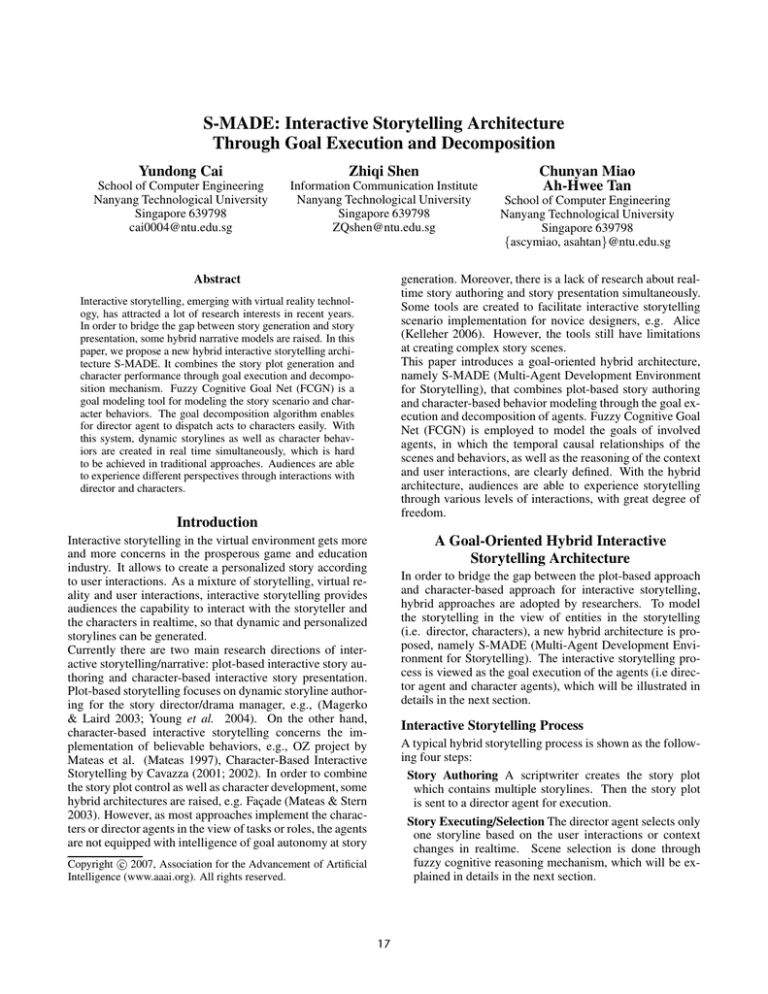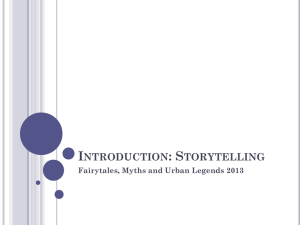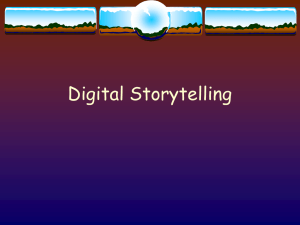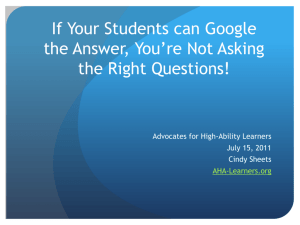
S-MADE: Interactive Storytelling Architecture
Through Goal Execution and Decomposition
Yundong Cai
Zhiqi Shen
School of Computer Engineering
Nanyang Technological University
Singapore 639798
cai0004@ntu.edu.sg
Information Communication Institute
Nanyang Technological University
Singapore 639798
ZQshen@ntu.edu.sg
Chunyan Miao
Ah-Hwee Tan
School of Computer Engineering
Nanyang Technological University
Singapore 639798
{ascymiao, asahtan}@ntu.edu.sg
generation. Moreover, there is a lack of research about realtime story authoring and story presentation simultaneously.
Some tools are created to facilitate interactive storytelling
scenario implementation for novice designers, e.g. Alice
(Kelleher 2006). However, the tools still have limitations
at creating complex story scenes.
This paper introduces a goal-oriented hybrid architecture,
namely S-MADE (Multi-Agent Development Environment
for Storytelling), that combines plot-based story authoring
and character-based behavior modeling through the goal execution and decomposition of agents. Fuzzy Cognitive Goal
Net (FCGN) is employed to model the goals of involved
agents, in which the temporal causal relationships of the
scenes and behaviors, as well as the reasoning of the context
and user interactions, are clearly defined. With the hybrid
architecture, audiences are able to experience storytelling
through various levels of interactions, with great degree of
freedom.
Abstract
Interactive storytelling, emerging with virtual reality technology, has attracted a lot of research interests in recent years.
In order to bridge the gap between story generation and story
presentation, some hybrid narrative models are raised. In this
paper, we propose a new hybrid interactive storytelling architecture S-MADE. It combines the story plot generation and
character performance through goal execution and decomposition mechanism. Fuzzy Cognitive Goal Net (FCGN) is a
goal modeling tool for modeling the story scenario and character behaviors. The goal decomposition algorithm enables
for director agent to dispatch acts to characters easily. With
this system, dynamic storylines as well as character behaviors are created in real time simultaneously, which is hard
to be achieved in traditional approaches. Audiences are able
to experience different perspectives through interactions with
director and characters.
Introduction
A Goal-Oriented Hybrid Interactive
Storytelling Architecture
Interactive storytelling in the virtual environment gets more
and more concerns in the prosperous game and education
industry. It allows to create a personalized story according
to user interactions. As a mixture of storytelling, virtual reality and user interactions, interactive storytelling provides
audiences the capability to interact with the storyteller and
the characters in realtime, so that dynamic and personalized
storylines can be generated.
Currently there are two main research directions of interactive storytelling/narrative: plot-based interactive story authoring and character-based interactive story presentation.
Plot-based storytelling focuses on dynamic storyline authoring for the story director/drama manager, e.g., (Magerko
& Laird 2003; Young et al. 2004). On the other hand,
character-based interactive storytelling concerns the implementation of believable behaviors, e.g., OZ project by
Mateas et al. (Mateas 1997), Character-Based Interactive
Storytelling by Cavazza (2001; 2002). In order to combine
the story plot control as well as character development, some
hybrid architectures are raised, e.g. Façade (Mateas & Stern
2003). However, as most approaches implement the characters or director agents in the view of tasks or roles, the agents
are not equipped with intelligence of goal autonomy at story
In order to bridge the gap between the plot-based approach
and character-based approach for interactive storytelling,
hybrid approaches are adopted by researchers. To model
the storytelling in the view of entities in the storytelling
(i.e. director, characters), a new hybrid architecture is proposed, namely S-MADE (Multi-Agent Development Environment for Storytelling). The interactive storytelling process is viewed as the goal execution of the agents (i.e director agent and character agents), which will be illustrated in
details in the next section.
Interactive Storytelling Process
A typical hybrid storytelling process is shown as the following four steps:
Story Authoring A scriptwriter creates the story plot
which contains multiple storylines. Then the story plot
is sent to a director agent for execution.
Story Executing/Selection The director agent selects only
one storyline based on the user interactions or context
changes in realtime. Scene selection is done through
fuzzy cognitive reasoning mechanism, which will be explained in details in the next section.
c 2007, Association for the Advancement of Artificial
Copyright Intelligence (www.aaai.org). All rights reserved.
17
sub goal nets. The hierarchical structure simplifies the goal
modeling process with different levels of abstraction. There
Scene Dispatching Each scene of the plot involves a number of characters and events, so that the director agent distributes the scene to relevant characters dynamically. The
director agent interprets the scene, assigns them to characters as behaviors accordingly. The story plot modeling
and behavior dispatching process are described in details
in the next section.
Character Performing The characters perform the behaviors assigned by director in the chronological sequence.
The composite behavior can be further decomposed to
atomic behaviors. Based on the user interactions and context changes, the characters select most appropriate behavior to execute.
Figure 1: Goal Net with the Alternative Storylines
Agents and Goals in Storytelling
are four types of transitions:sequence, choice, concurrency
and synchronization. A very complex goal can be represented with atomic goals and combination of transitions.
In FCGN, Fuzzy Cognitive Maps (FCMs) is adopted as the
inference mechanism for goal selection and task selection.
Fuzzy Cognitive Maps is a qualitative modeling tool proposed by Kosko (1986). By modeling the fuzzy causal relationships among concepts in a system, FCMs enables to
model complex system evolution in short run and long run,
which provides a more sophisticated result over one-step ifthen inference. A more detailed description of FCGN can be
found in (Cai et al. 2006).
Agents are goal-oriented, autonomous objects, which work
in specific context. Agent technology facilitates to model intelligent and believable storyteller and characters. The process of storytelling is the process of pursuing goals for involved agents in the storytelling. In a storytelling, the goals
of agents can be viewed in Table 1.
Goal
Atomic Goal
Role
Transition
Knowledge
Director
Story plot
Story Scene
Plot planning
Scene Transition
Global
Character
Scene act
State in act
Behavior planning
State Transition
Local
Director: Plot Planning with FCGN
Table 1: Goals of Agents in Storytelling
FCGN is a very expressive and efficient tool to model the
story plot. The scenes are related in chronological sequence.
In the model, each scene Si is represented as a goal, the
causal relationship between scene Si and Si+1 is represented
with transition Ti . As shown in Figure 1, multiple storylines
are available due to user interactions or context changes.
Different storyline can be achieved by director with ‘Choice’
mechanism. For example, after scene S1, the director would
decide whether next scene is S2 or S4 based on selection criteria. The FCGN represents the goals of the director agent,
i.e, story scenes. A complex scene is represented as a composite goal, and a simple scene is represented as an atomic
goal. A complex scene is split into small scenes for story
narrative.
The transitions of goal net are capable of describing different relationships between story scenes in storytelling. The
sequence transition is used when two scenes has temporal causal relationships. The concurrency transition is used
when two scenes are independent, such that the presentation
order is not important. The choice transition is the most important to the user interaction and context variables change,
as it might lead to different scene after the current scene.
The synchronization transition is needed for the concurrent
scenes, such that the next scene can be achieved only after
the concurrent scenes are achieved. Moreover, the combination of transitions allows to model complicated relationships
among scenes, thus it is able to model a very complex storytelling.
Fuzzy Cognitive Goal Net (FCGN)
An efficient model/language is required for the communication between the director and characters, in order to achieve
the autonomy of story generation and story performing. In
our hybrid architecture, Fuzzy Cognitive Goal Net (FCGN)
(2006) is used to model story plots for director and behaviors for characters respectively. Through the behavior dispatching mechanism, the director assigns the behaviors for
the characters involved in story scenes dynamically. In (Cai
et al. 2006), FCGN has been used to model the story plot
for single director to narrate an interactive story.
Structure of FCGN
As shown in Figure 1, FCGN is composed of goals and transitions. Goals, represented by circles, are used to represent
the goals that an agent needs to pursue in order to achieve
final goal. Transitions, represented by arcs and vertical bars,
connect from the a goal to a output goal, specifying the relationship between the two goals. Each transition is associated
with a task list which defines the possible tasks that the agent
needs to perform in order to transit from the input goal to the
output goal.
In FCGN, an atomic goal represents a primitive state which
cannot be further divided, while a composite goal can be
split into goals connected via transitions. Therefore, a complex goal can be recursively decomposed into sub-goals and
18
Character: Behavior Planning with FCGN
agents are achieved by reasoning mechanism in a goal net.
In FCGN, Fuzzy Cognitive Maps is able to model the dynamic evolution of context changes as well as user interactions, provides basis for goal selection and action selection.
Different from other reasoning mechanism, e.g rule-based
engine, it is able to work with incomplete information, thus
it is helpful for reasoning with different number of factors.
With FCM inference, it is able to achieve a sophisticated
decision in the case that there is a loop among the causal relationships, which can’t be achieved for simple if-then rules.
A small comparison of FCM with Hierarchical Task Network (HTN) is shown in Table 2. It shows that FCGN empowers HTN with abilities of goal abstracting, which provides a better modeling to increase agent intelligence.
In the same way, FCGN is also used as goal model of virtual
characters, i.e to model the acts that characters need to perform. In interactive storytelling, the acts for a single character are not linear in response to user interactions, which
is same as story plot. Here, the goals of character are the
acts/behaviors assigned by the director. The characters perform the scene according to the chronological order of the
acts. Different transitions imply the different causal relationships for the acts. As a believably entity, character also
monitors user interactions and relevant context changes, to
make reasonable act.
Behavior Dispatching
By using the same goal model, the director is able to dispatch the scenes to virtual characters seamlessly, through the
goal decomposition algorithm. Therefore, both the story authoring autonomy and character behavior autonomy can be
achieved. Behavior dispatching is an important step wherein
the director agent assigns the behaviors to different characters in a scene autonomously and dynamically. Director
agent will decompose a scene into sub-scenes in parallel for
characters which are involved. An algorithm for scene dispatching is shown as
Structure
Purpose
Selection
Mechanism
Re-plan
FCGN
Tree
Goal Planning
Fuzzy Cognitive
Maps
No
HTN
Tree
Task Planning
Precondition
Yes
Table 2: Comparison between FCGN and HTN
Given: Scene $S = [$AC_1, ... $AC_n, $B, $C]
Case Study: “Mystery Illness Investigation at
Nanyang Town”
IF $S is Composite
$Q <= Child(S)
While ($Q is not empty)
$S_t <= $Q
For i = 1 to n do
$B_i = Find ($S_t, $B, $AC_i, $C)
$AC_i <= $B_i
End
End
Story Implementation
A story, namely “Mystery Illness Investigation at Nanyang
Town”, was implemented using the hybrid approach. The
story is about a group of visitors explore the virtual town
and investigate the mystery illness. By communicating with
virtual characters, or conducting lab experiments, the protagonists find the causes of the mystery disease, and prevent
a disaster successfully .
The story plot is modeled as shown in Figure 2, in which the
investigators have different choices in the investigation. For
example, he/she can go to either the hospital or the clinic to
check the symptoms of the mystery illness and how widely
the illness has spread. Depending on the availability of the
officer in health ministry, the investigators can check differences of diseases from government officer, or from library
books. The director agent selects a storyline dynamically
Function: $B_i= Find ($S_t, $B, $AC_i, $C)
FOR $AC_i IN $S
IF $B_i is independent \%parallel
RETURN $B_i
ELSE IF $B_i is dependent of $B_j
IF $B_j is done
RETURN $B_i
ELSE
RETURN IDLE
ELSE
RETURN IDLE
As shown in the algorithm, independent acts for characters
can be performed by characters at the same time, e.g. two
characters walk to each other. If there is interaction between
the two characters, a synchronization is required to synchronize the acts, i.e, characters wait until dependent acts finish.
Characters might call its own act performance with respect
to typical act assigned by director agent, so that it can be
modeled to handle user interactions.
$%
&
!
"#
&'
Reasoning Mechanism using Fuzzy Cognitive Maps
To allow an engaging experience for users, the director and
characters need to react intelligently to user interactions and
context changes. Such dynamic storyline selection for director agent and dynamic behavior selection for character
Figure 2: Fuzzy Cognitive Goal Net for Illness Investigation
Story
19
based on the user interactions and the current context. A
selected storyline for one investigator is shown in Figure
2 with goals shaded, in which the investigator first visited
the hospital for illness symptoms, then went to query about
the differences of the illnesses from books, lastly went to
visit the town to confirm the conclusion. Figure 3 shows a
Conclusions
>? @ABCCD
>E @FGHI JK
>L @MCNJOGH PQCOI
>R @SJTDCK
>U @VKDBWNXOC
>Y @ABCCD
>Z @[GDJCKD
()*)+
,-*.)+/0
In this paper, we propose a goal-oriented hybrid interactive storytelling architecture, namely S-MADE, to achieve
the storytelling through goal execution and decomposition.
Fuzzy Cognitive Goal Net (FCGN) is used to model story
plots as well as character behaviors for director and characters respectively. The director agent and character agents
are connected seamlessly through goal decomposition algorithm. As a result, story authoring autonomy and character
behavior generation autonomy are achieved. Audiences are
able to make the interactions at different levels of authoring
and storytelling.
3=
34
1+/2+
The director has high-level abstraction over the story scenes
and characters have low-level abstraction over detailed scene
acts. In the storytelling process, the audiences are able to
affect the decision of director as well as single character,
which promotes the engaging and immersive experience.
39
38
3:
3;
567
3<
Figure 3: “Visit Hospital Scene” for Doctor Agent
References
detailed design of scene “visit the hospital”. The scene involves three characters: an investigator, a doctor and a nurse,
and the behaviors of whom are shown vertically separated by
lines respectively. The director agent dispatches the behaviors to characters through behavior dispatching mechanism.
The visualization engine is ActiveWorlds 3-D virtual environment powered by Renderware. Some snapshots are
shown in Figure 4, in which characters perform the behaviors assigned by the director at different stages.
Cai, Y.; Miao, C.; Tan, A.-H.; and Shen, Z. 2006. Fuzzy
cognitive goal net for interactive storytelling plot design.
In Proceedings of International Conference on Advances
in Computer Entertainment Technology, 56. New York,
NY, USA: ACM Press.
Cavazza, M.; Charles, F.; and Mead, S. 2002. Characterbased interactive storytelling. Intelligent Systems, IEEE
[see also IEEE Intelligent Systems and Their Applications]
17(4):17–24.
Charles, F.; Mead, S.; and Cavazza, M. 2001. Characterdriven story generation in interactive storytelling. In Virtual Systems and Multimedia, 2001. Proceedings. Seventh
International Conference on, 609–615.
Crawford, C. 2005. Chris Crawford on Interactive Storytelling. Berkeley, CA, US: New Riders.
Kelleher, C. 2006. Alice: Using 3d gaming technology
to draw students into computer science. In Proceedings
of the Fourth Game Design and Technology Workshop and
Conference (GDTW 2006), 16–20. Liverpool, UK: ACM
Press.
Kosko, B. 1986. Fuzzy cognitive maps. International
Journal of Man Machine Studies 24:66–75.
Magerko, B., and Laird, J. 2003. Building an interactive
drama architecture. In First International Conference on
Technologies for Interactive Digital Storytelling and Entertainment, 226–237.
Mateas, M., and Stern, A. 2003. Façade: An experiment
in building a fully-realized interactive drama. In Game Developers Conference, Game Design track.
Mateas, M. 1997. An oz-centric review of interactive
drama and believable agents. In AI Today: Recent Trends
and Developments., volume 1600, 297–328.
Young, R. M.; Riedl, M. O.; Branly, M.; Jhala, A.; Martin,
R. J.; and Saretto, C. J. 2004. An architecture for integrating plan-based behavior generation with interactive game
environments. Journal of Game Development 1(1):51–70.
(a)
(b)
(c)
(d)
Figure 4: Snapshots for (a) talking to the doctor at the first
time as protagonist (b) talking to the doctor at the second
time (c) nurse visiting the patient (d) nurse reporting to doctor
Results
In the implementation, story plot and character behaviors
are generated in real-time with respect to user interactions.
20







